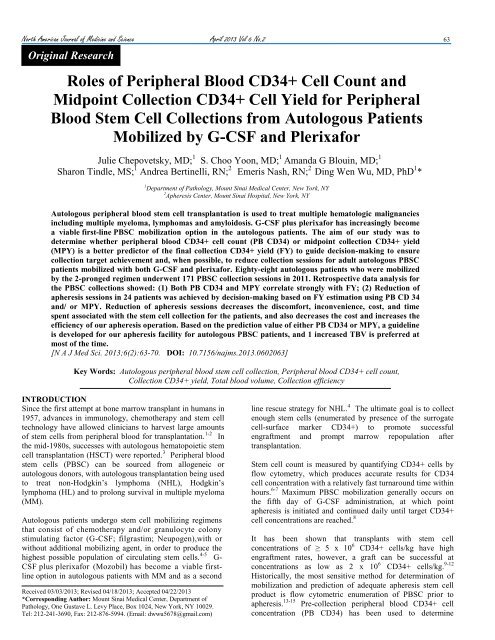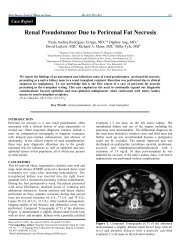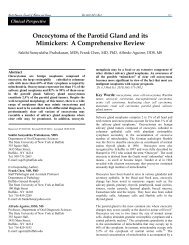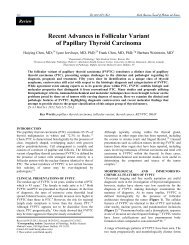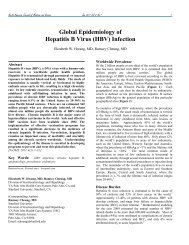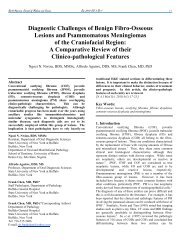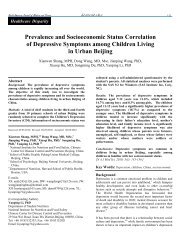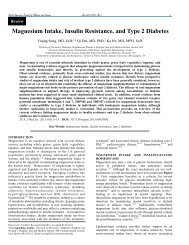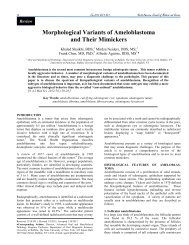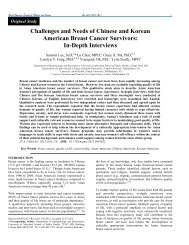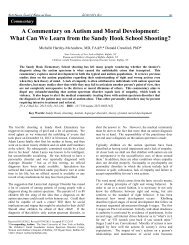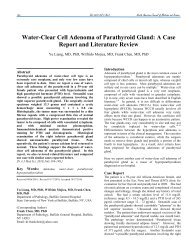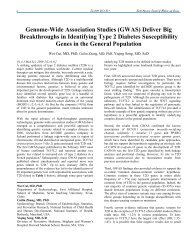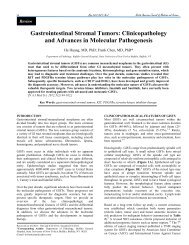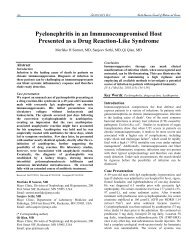Roles of Peripheral Blood CD34+ Cell Count and Midpoint ...
Roles of Peripheral Blood CD34+ Cell Count and Midpoint ...
Roles of Peripheral Blood CD34+ Cell Count and Midpoint ...
You also want an ePaper? Increase the reach of your titles
YUMPU automatically turns print PDFs into web optimized ePapers that Google loves.
North American Journal <strong>of</strong> Medicine <strong>and</strong> Science April 2013 Vol 6 No.2 63<br />
Original Research<br />
<strong>Roles</strong> <strong>of</strong> <strong>Peripheral</strong> <strong>Blood</strong> <strong>CD34+</strong> <strong>Cell</strong> <strong>Count</strong> <strong>and</strong><br />
<strong>Midpoint</strong> Collection <strong>CD34+</strong> <strong>Cell</strong> Yield for <strong>Peripheral</strong><br />
<strong>Blood</strong> Stem <strong>Cell</strong> Collections from Autologous Patients<br />
Mobilized by G-CSF <strong>and</strong> Plerixafor<br />
Julie Chepovetsky, MD; 1 S. Choo Yoon, MD; 1 Am<strong>and</strong>a G Blouin, MD; 1<br />
Sharon Tindle, MS; 1 Andrea Bertinelli, RN; 2 Emeris Nash, RN; 2 Ding Wen Wu, MD, PhD 1 *<br />
1 Department <strong>of</strong> Pathology, Mount Sinai Medical Center, New York, NY<br />
2 Apheresis Center, Mount Sinai Hospital, New York, NY<br />
Autologous peripheral blood stem cell transplantation is used to treat multiple hematologic malignancies<br />
including multiple myeloma, lymphomas <strong>and</strong> amyloidosis. G-CSF plus plerixafor has increasingly become<br />
a viable first-line PBSC mobilization option in the autologous patients. The aim <strong>of</strong> our study was to<br />
determine whether peripheral blood <strong>CD34+</strong> cell count (PB CD34) or midpoint collection <strong>CD34+</strong> yield<br />
(MPY) is a better predictor <strong>of</strong> the final collection <strong>CD34+</strong> yield (FY) to guide decision-making to ensure<br />
collection target achievement <strong>and</strong>, when possible, to reduce collection sessions for adult autologous PBSC<br />
patients mobilized with both G-CSF <strong>and</strong> plerixafor. Eighty-eight autologous patients who were mobilized<br />
by the 2-pronged regimen underwent 171 PBSC collection sessions in 2011. Retrospective data analysis for<br />
the PBSC collections showed: (1) Both PB CD34 <strong>and</strong> MPY correlate strongly with FY; (2) Reduction <strong>of</strong><br />
apheresis sessions in 24 patients was achieved by decision-making based on FY estimation using PB CD 34<br />
<strong>and</strong>/ or MPY. Reduction <strong>of</strong> apheresis sessions decreases the discomfort, inconvenience, cost, <strong>and</strong> time<br />
spent associated with the stem cell collection for the patients, <strong>and</strong> also decreases the cost <strong>and</strong> increases the<br />
efficiency <strong>of</strong> our apheresis operation. Based on the prediction value <strong>of</strong> either PB CD34 or MPY, a guideline<br />
is developed for our apheresis facility for autologous PBSC patients, <strong>and</strong> 1 increased TBV is preferred at<br />
most <strong>of</strong> the time.<br />
[N A J Med Sci. 2013;6(2):63-70. DOI: 10.7156/najms.2013.0602063]<br />
Key Words: Autologous peripheral blood stem cell collection, <strong>Peripheral</strong> blood <strong>CD34+</strong> cell count,<br />
Collection <strong>CD34+</strong> yield, Total blood volume, Collection efficiency<br />
INTRODUCTION<br />
Since the first attempt at bone marrow transplant in humans in<br />
1957, advances in immunology, chemotherapy <strong>and</strong> stem cell<br />
technology have allowed clinicians to harvest large amounts<br />
<strong>of</strong> stem cells from peripheral blood for transplantation. 1-2 In<br />
the mid-1980s, successes with autologous hematopoietic stem<br />
cell transplantation (HSCT) were reported. 3 <strong>Peripheral</strong> blood<br />
stem cells (PBSC) can be sourced from allogeneic or<br />
autologous donors, with autologous transplantation being used<br />
to treat non-Hodgkin’s lymphoma (NHL), Hodgkin’s<br />
lymphoma (HL) <strong>and</strong> to prolong survival in multiple myeloma<br />
(MM).<br />
Autologous patients undergo stem cell mobilizing regimens<br />
that consist <strong>of</strong> chemotherapy <strong>and</strong>/or granulocyte colony<br />
stimulating factor (G-CSF; filgrastim; Neupogen),with or<br />
without additional mobilizing agent, in order to produce the<br />
highest possible population <strong>of</strong> circulating stem cells. 4-5 G-<br />
CSF plus plerixafor (Mozobil) has become a viable firstline<br />
option in autologous patients with MM <strong>and</strong> as a second<br />
Received 03/03/2013; Revised 04/18/2013; Accepted 04/22/2013<br />
*Corresponding Author: Mount Sinai Medical Center, Department <strong>of</strong><br />
Pathology, One Gustave L. Levy Place, Box 1024, New York, NY 10029.<br />
Tel: 212-241-3690, Fax: 212-876-5994. (Email: dwwu5678@gmail.com)<br />
line rescue strategy for NHL. 4 The ultimate goal is to collect<br />
enough stem cells (enumerated by presence <strong>of</strong> the surrogate<br />
cell-surface marker <strong>CD34+</strong>) to promote successful<br />
engraftment <strong>and</strong> prompt marrow repopulation after<br />
transplantation.<br />
Stem cell count is measured by quantifying <strong>CD34+</strong> cells by<br />
flow cytometry, which produces accurate results for CD34<br />
cell concentration with a relatively fast turnaround time within<br />
hours. 6-7 Maximum PBSC mobilization generally occurs on<br />
the fifth day <strong>of</strong> G-CSF administration, at which point<br />
apheresis is initiated <strong>and</strong> continued daily until target <strong>CD34+</strong><br />
cell concentrations are reached. 8<br />
It has been shown that transplants with stem cell<br />
concentrations <strong>of</strong> ≥ 5 x 10 6 <strong>CD34+</strong> cells/kg have high<br />
engraftment rates, however, a graft can be successful at<br />
concentrations as low as 2 x 10 6 <strong>CD34+</strong> cells/kg. 9-12<br />
Historically, the most sensitive method for determination <strong>of</strong><br />
mobilization <strong>and</strong> prediction <strong>of</strong> adequate apheresis stem cell<br />
product is flow cytometric enumeration <strong>of</strong> PBSC prior to<br />
apheresis. 13-15 Pre-collection peripheral blood <strong>CD34+</strong> cell<br />
concentration (PB CD34) has been used to determine
64 April 2013 Vol 6 No.2 North American Journal <strong>of</strong> Medicine <strong>and</strong> Science<br />
necessity <strong>of</strong> the apheresis procedure, processing volume <strong>and</strong><br />
number <strong>of</strong> procedure days. 16-19 Other studies have evaluated<br />
the predictive potential <strong>of</strong> intra-procedural enumeration <strong>of</strong><br />
<strong>CD34+</strong> cell concentration on final stem cell yield (FY) in the<br />
setting <strong>of</strong> fixed-volume apheresis <strong>and</strong> in the pediatric<br />
population. 20-22 To our knowledge, predictive values <strong>of</strong> both<br />
PB CD34 <strong>and</strong> midpoint collection <strong>CD34+</strong> yield (MPY) have<br />
not been reported for patients mobilized with both G-CSF <strong>and</strong><br />
plerixafor.<br />
Here we report our findings for predictive values <strong>of</strong> both PB<br />
CD34 <strong>and</strong> MPY on FY for adult autologous PBSC patients<br />
mobilized with G-CSF <strong>and</strong> plerixafor.<br />
METHODS<br />
At our institution, the minimum <strong>and</strong> optimal stem cell<br />
collection targets for autologous patients with diagnosis <strong>of</strong><br />
lymphoma <strong>and</strong> leukemia are 2.5 x 10 6 <strong>and</strong> 5 x 10 6 <strong>CD34+</strong><br />
cells/kg body weight, respectively. The minimum target <strong>and</strong><br />
optimal stem cell collection target (OT) for patients with<br />
multiple myeloma (MM) are 5 x 10 6 <strong>and</strong> 10 x 10 6<br />
11, 23<br />
<strong>CD34+</strong>cells/kg, respectively.<br />
Hypothesis<br />
The aim <strong>of</strong> our study was to determine whether PB CD34 or<br />
MPY is a better predictor <strong>of</strong> FY to guide decision-making to<br />
ensure collection target achievement <strong>and</strong>, when possible, to<br />
reduce collection sessions.<br />
We hypothesize: (1) MPY is a good predictor for FY; (2)<br />
MPY correlates with FY stronger than does PB CD34; (3)<br />
Both PB CD34 <strong>and</strong> MPY can be used to influence the<br />
decision to process a larger apheresis volume to decrease the<br />
number <strong>of</strong> days required to achieve stem cell collection target.<br />
This would decrease the patient’s use <strong>of</strong> mobilizing agents,<br />
decrease the potential side effects associated with the<br />
procedure, <strong>and</strong> lower the overall cost <strong>of</strong> the PBSC<br />
collection. 24<br />
Patients<br />
In 2011, a total <strong>of</strong> 171 autologous PBSC collection sessions<br />
were performed for 100 adult patients mobilized by both G-<br />
CSF <strong>and</strong> plerixafor. All 100 patients received 5 doses (1 dose<br />
per day) <strong>of</strong> G-CSF (~8-10 μg/kg) <strong>and</strong> one dose <strong>of</strong> plerixafor<br />
(~ 0.24 mg/kg) before starting stem cell collection. Both<br />
medications were continued prior to each anticipated<br />
apheresis session. A patient’s first collection leukapheresis<br />
session was scheduled on the 5 th day <strong>of</strong> G-CSF<br />
administration, which usually correlates with peak circulating<br />
PBSC concentration. 25 Plerixafor was administered the<br />
evening before each apheresis session.<br />
A retrospective analysis study was conducted for PBSC<br />
collection <strong>of</strong> these autologous patients. Twelve patients were<br />
excluded from this study because <strong>of</strong> incomplete data, late<br />
mid-point apheresis product sampling or initial PB CD34 < 10<br />
cells/μL. The remaining 88 patients underwent 143 stem cell<br />
collection sessions. Of these, 2.3% (n=2) had a diagnosis <strong>of</strong><br />
amyloidosis, 5.7% (n=5) had HL, 12.5 % (n=11) had NHL<br />
<strong>and</strong> 79.5% (n=70) had MM.<br />
Stem <strong>Cell</strong> Collection Methodology <strong>and</strong> Design<br />
Mononucleated cell leukapheresis was performed for PBSC<br />
collection using Terumo BCT COBE Spectra Apheresis<br />
System (Lakewood, CO, USA). Extracorporeal<br />
anticoagulation was achieved with acid citrate dextrose A<br />
(ACD-A), <strong>and</strong> citrate-induced hypocalcemia was managed<br />
with calcium gluconate. Collection volumes were measured<br />
by number <strong>of</strong> total blood volumes (TBV), computed with the<br />
COBE Spectra apparatus. The collections were performed via<br />
peripheral intravenous access or centrally placed doublelumen<br />
catheters.<br />
Usually no more than 4 collection sessions (i.e. days) are<br />
performed during an autologous PBSC collection cycle at our<br />
facility, because central venous catheter is usually inserted to<br />
the patients on Monday, <strong>and</strong> the collection starts on the next<br />
day. Default 3 TBV was processed for autologous PBSC<br />
collection, <strong>and</strong> PB CD34 historically was the only predictor<br />
for FY to determine if the collection session should proceed.<br />
If PB CD34 was less than 10 cells/µL, the FY was expected to<br />
be less than 1x 10 6 CD 34+ cells/kg, <strong>and</strong> the autologous PBSC<br />
collection for MM may not proceed, because even the<br />
minimal target could not be reached within the 4-day<br />
collection cycle.<br />
To test our hypothesis, 3 changes were made for autologous<br />
PBSC collections at our institution in 2011: (1) Both PB<br />
CD34 <strong>and</strong> MPY (taken at 1.5 TBV processed volume) were<br />
determined for each collection session; (2) Both PB CD34 <strong>and</strong><br />
MPY were used to predict FY <strong>of</strong> the collection session; (3)<br />
The estimated FY was then used to guide our decision-making<br />
on possible adjustment <strong>of</strong> blood volume to process, in order to<br />
reduce the number <strong>of</strong> collection days, when possible.<br />
Processing volume for each collection session was sometimes<br />
increased beyond 3 TBV at the apheresis physician’s<br />
discretion.<br />
The daily maximum volume <strong>of</strong> TBV to process was mainly<br />
limited by the operation hours <strong>of</strong> the apheresis facility <strong>and</strong><br />
patient’s arrival time. The apheresis facility operates 8 hours<br />
daily on weekdays, <strong>and</strong> thus 4 TBV is the maximal daily<br />
processing volume that can be accomplished in the operation<br />
time frame. Sessions with less than 3 TBV processed were<br />
<strong>of</strong>ten due to patient’s late arrival, PB CD34 < 10 cells/uL or<br />
an early collection stop upon reaching OT.<br />
Measurement <strong>of</strong> CD 34+ <strong>Cell</strong> <strong>Count</strong>s<br />
Flow cytometric measurement <strong>of</strong> stem cell <strong>CD34+</strong> counts are<br />
performed by the in house Flow Cytometry Laboratory using<br />
the Stem-Kit <strong>CD34+</strong> HPC Enumeration Kit, (Beckman<br />
Coulter, FL, USA) applying a single-platform modified<br />
ISAGE protocol. 24 Automated stem cell counts were<br />
performed on the Beckman Coulter Gallios Cytometer<br />
(Beckman Coulter, FL, USA). Flow cytometry was performed<br />
on a 10 mL sample <strong>of</strong> pre-apheresis heparinized peripheral<br />
blood to determine PB CD34, a 0.5-1 mL EDTA<br />
anticoagulated sample <strong>of</strong> the apheresis collection product at<br />
the midpoint <strong>of</strong> the collection (corresponding to processed<br />
volume <strong>of</strong> 1.5 TBV) to determine MPY <strong>and</strong> another 0.5-1 mL<br />
sample <strong>of</strong> the apheresis product at the end <strong>of</strong> the collection
North American Journal <strong>of</strong> Medicine <strong>and</strong> Science April 2013 Vol 6 No.2 65<br />
session to determine final collection product CD34 yield (FY).<br />
Pre-collection <strong>and</strong> midpoint samples were taken by the<br />
apheresis nurses <strong>and</strong> the final collection product was sampled<br />
at our stem cell processing laboratory (<strong>Cell</strong>ular Therapy<br />
Laboratory).<br />
Estimation <strong>of</strong> FY, Calculation <strong>of</strong> MPY, FY, Collection<br />
Efficiency<br />
To calculate MPY <strong>and</strong> FY, the related CD34 count measured<br />
by flow cytometry was multiplied by the apheresis product<br />
volume <strong>and</strong> divided by the recipient’s body weight (kg). MPY<br />
was calculated at the apheresis facility while FY was<br />
calculated at the <strong>Cell</strong>ular Therapy Laboratory.<br />
Estimation <strong>of</strong> daily FY (<strong>CD34+</strong> cells x106/kg) at 3 TBV was<br />
made by dividing PB CD34 by a factor <strong>of</strong> 10. After receiving<br />
the MPY (<strong>CD34+</strong> cells x106/kg) (at 1.5 TBV) result, a new<br />
estimation <strong>of</strong> FY (at 3 TBV) was made by multiplying MPY<br />
by a factor <strong>of</strong> 2.<br />
Calculated MPY = midpoint apheresis product stem cell<br />
CD34 count (cells/μL) x midpoint apheresis product volume<br />
(μL) ÷ patient’s weight (kg)<br />
Calculated FY = final apheresis product stem cell CD34 count<br />
(cells/μL) x final apheresis product volume (μL) ÷ patient’s<br />
weight (kg)<br />
Collection efficiency (CE) is the ratio <strong>of</strong> number <strong>of</strong> <strong>CD34+</strong><br />
cells collected to the number <strong>of</strong> <strong>CD34+</strong> cells processed. It is<br />
calculated through the following 4 steps:<br />
<strong>Blood</strong> volume processed = (Final inlet flow volume) minus<br />
(final anticoagulation volume) displayed at the end <strong>of</strong> the<br />
collection session by the COBE Spectra Apheresis System.<br />
Number <strong>of</strong> <strong>CD34+</strong> cells processed = (PB CD34) x (blood<br />
volume processed)<br />
Number <strong>of</strong> <strong>CD34+</strong> cells collected = (CD34 cell concentration<br />
in final product) x (final product volume)<br />
CE = (<strong>CD34+</strong> cells collected) / (<strong>CD34+</strong> cells processed)<br />
Statistical Analysis<br />
Retrospective analysis was performed to determine the<br />
correlations between PB CD34 <strong>and</strong> FY vs. MPY <strong>and</strong> FY.<br />
Correlation <strong>and</strong> linear regression analysis were used for a<br />
subset <strong>of</strong> 53 patients who underwent ~3 TBV (between 2.7-<br />
3.4 TBV) processing in a total <strong>of</strong> 86 sessions. All patients in<br />
this subset had MPY sampled at the time when 1.5 TBV was<br />
processed.<br />
Figure 1. Regression analysis with linear fit plot shows a strong correlation<br />
<strong>and</strong> mathematic relationship between PB CD34 <strong>and</strong> FY for autologous<br />
PBSC patients mobilized by G-CSF <strong>and</strong> plerixafor.<br />
Figure 2. Regression analysis with linear fit plot showed a strong<br />
correlation between MPY <strong>and</strong> FY for autologous PBSC patients mobilized<br />
by G-CSF <strong>and</strong> plerixafor.<br />
RESULTS<br />
Determination <strong>of</strong> PB CD34, MPY, FY <strong>and</strong> Collection<br />
Efficiency (CE)<br />
A total <strong>of</strong> 143 sessions <strong>of</strong> apheresis collection were performed<br />
on 88 patients with volumes processed ranging from 1.4 TBV<br />
to 5.0 TBV (median=3.1 TBV). Only one <strong>of</strong> the sessions<br />
processed 5.0 TBV, the rest processed 4.4 TBV or less. PB<br />
CD34 ranged from 2 - 377 cells/μL (median 44 <strong>CD34+</strong><br />
cells/μL), MPY ranged from 0.09 - 21.47 x10 6 <strong>CD34+</strong><br />
cells/kg (median=2.41 x10 6 <strong>CD34+</strong> cells/kg). Daily FY<br />
ranged from 0.18 - 40.07 x10 6 <strong>CD34+</strong> cells/kg (median=4.91<br />
x10 6 <strong>CD34+</strong> cells/kg). CE ranged from 21.92% - 123.42%
66 April 2013 Vol 6 No.2 North American Journal <strong>of</strong> Medicine <strong>and</strong> Science<br />
(median 56%). All patients included in our study achieved at<br />
least minimal target stem cell concentrations during their<br />
collection cycle.<br />
Effects <strong>of</strong> Estimated FY based on PB CD34 <strong>and</strong> MPY for<br />
Decision-making<br />
A sample <strong>of</strong> representative patient data (11 patients with 13<br />
collection sessions) is shown in Table 1. During each<br />
collection session, PB CD34 <strong>and</strong> MPY were reviewed in<br />
order to estimate FY at 3 TBV as described above. Based on<br />
this estimation, the apheresis physician made the decision<br />
whether or not to increase processed volume beyond 3 TBV in<br />
order to reach OT in fewer apheresis sessions. As shown in<br />
the representative patient examples in Table 1, processed<br />
TBV was increased beyond 3.4 TBV for patients # 4, 5, 9, 10<br />
<strong>and</strong> 11; consequently, the number <strong>of</strong> collection sessions to<br />
reach OT for each <strong>of</strong> these patients was reduced by one<br />
session.<br />
Table 1. Product Yield <strong>and</strong> CD34 Efficiency Data <strong>of</strong> Representative Patients.<br />
Patient<br />
#<br />
Diagnosis<br />
Optimal<br />
Target<br />
(CD34x<br />
10e6/kg)<br />
Collection<br />
Day #<br />
PB<br />
CD34<br />
(/ul)<br />
MPY<br />
(CD34x10e6/<br />
kg)<br />
# <strong>of</strong> TBV<br />
Processed<br />
FY<br />
(CD34x10e<br />
6/kg)<br />
# <strong>of</strong> Expected<br />
Collection<br />
Days<br />
(if 3 TBV/day)<br />
Actual #<br />
<strong>of</strong><br />
Collection<br />
Days<br />
1 NHL 5 Day 1 54 2.42 3.0 6.03 1 1 0 55<br />
2 MM 10 Day 1 125 10.17 3.0 19.72 1 1 0 83<br />
3 MM 10 Day 1 104 5.44 3.0 10.55 1 1 0 47<br />
4 MM 10 Day 1 87 5.68 3.6 11.44 2 1 1 52<br />
5 MM 10 Day 1 80 6.32 3.5 9.31 2 1 1 55<br />
6 MM 10 Day 1 102 6.06 3.0 11.76 1 1 0 69<br />
7 MM 10 Day 1 150 10.11 3.0 21.3 1 1 0 95<br />
8 MM 10 Day 1 148 6.22 3.0 9.62 1 1 0 42<br />
9 Amyloidosis 10 Day 1 310 4.95 3.6 11.7 2 1 1 25<br />
# <strong>of</strong><br />
Saved<br />
Days<br />
CE<br />
(%)<br />
10 MM 10 Day 1 32 2.67 4.0 6.02 3 2 1 72<br />
10 MM 10 Day 2 17 2.52 4.1 4.91 3 2 1 123<br />
11 MM 10 Day 1 50 3.30 4.1 5.56 3 2 1 49<br />
11 MM 10 Day 2 48 3.60 4.4 5.81 3 2 1 49<br />
PBCD34 = Pre-collection peripheral blood CD34 (cells/uL)<br />
MPY = <strong>Midpoint</strong> collection yield CD34 (x10 6 <strong>CD34+</strong> cells/kg)<br />
TBV = Total blood volume<br />
FY = Final collection product yield CD34 (x10 6 <strong>CD34+</strong> cells/kg)<br />
CE = Collection Efficiency (%)<br />
Table 2. R-square values <strong>of</strong> regression linear fit analysis (n = 86).<br />
PB CD34 0.035293<br />
CE PB CD34 MPY<br />
MPY -0.008657 0.823305<br />
FY -0.011811 0.880656 0.913202<br />
PBCD34 = Pre-collection peripheral blood CD34 (cells/uL)<br />
MPY = <strong>Midpoint</strong> collection yield CD34 (x106 <strong>CD34+</strong> cells/kg)<br />
FY = Final collection product yield CD34 (x106 <strong>CD34+</strong> cells/kg)<br />
CE = Collection Efficiency (%)
North American Journal <strong>of</strong> Medicine <strong>and</strong> Science April 2013 Vol 6 No.2 67<br />
Table 3. Effect <strong>of</strong> Processed TBV on Number <strong>of</strong> Collection Sessions for OT ≥ 10x10 6 <strong>CD34+</strong> cells/kg.<br />
PB<br />
CD34<br />
Number <strong>of</strong><br />
TBV<br />
processed<br />
Per<br />
Session*<br />
PB CD34 based Evidence<br />
Number <strong>of</strong><br />
Collection<br />
Days to reach<br />
OT<br />
Evidence<br />
MPY<br />
Number <strong>of</strong><br />
TBV<br />
processed Per<br />
Session*<br />
MPY based Evidence<br />
Number <strong>of</strong><br />
Collection<br />
Days to<br />
reach OT<br />
Evidence<br />
≥108 3 1<br />
19 out <strong>of</strong> 20 (19/20)<br />
26 out <strong>of</strong> 28 (26/28)<br />
≥ 5.5 3 1<br />
patients reached OT<br />
patients<br />
81 - 108 4 1 8 out <strong>of</strong> 8 patients (8/8) 4.1 - 5.5 4 1 5 / 6 patients<br />
81 - 108 3 1 - 2<br />
4 /6 patients reached<br />
2/ 4 reached<br />
4.1 - 5.5 3 1 - 2<br />
OT within 1 day<br />
OT within 1 day.<br />
61 - 80 4 1 - 2<br />
4 /6 patients reached<br />
1 / 3 reached OT within a<br />
3.1 - 4.0 4 1 - 2<br />
OT within 1 day.<br />
day.<br />
61 - 80 3 1- 2<br />
3/4 sessions reached<br />
2/4 reached OT within<br />
3.1 - 4.0 3 2 - 3 >5x10 6 / kg a day; none<br />
1 day.<br />
reached OT in 1 day.<br />
41 - 60 3 - 4 2 -3<br />
21- 40 4 3 – 4<br />
21- 40 3 3-4, mostly 4<br />
10 - 20 4<br />
3 or more,<br />
(mostly 4)<br />
10 - 20 3 4 or more<br />
5/8 sessions with 4BV<br />
<strong>and</strong> 6 /11 with 3TBV<br />
reached >5x10 6 /kg a<br />
day. Others did not.<br />
5/7: >4.0 x10 6 /kg;<br />
1/14: >4.0 x10 6 /kg;<br />
2/5: >3.5 x10 6 /kg;<br />
1/14: >3.0 x10 6 /kg,<br />
2.1 - 3.0 3-4 2 – 3<br />
9/14 with 4TBV/ session<br />
<strong>and</strong> 5/6 with 3TBV<br />
reached<br />
>5 x10 6 /kg.<br />
1.1 - 2.0 4 3 - 4 3/9 >3.5 x10 6 /kg.<br />
1.1 - 2.0 3 3-4, mostly 4<br />
10/21: >2.5 x10 6 /kg,<br />
among them, 4/21:>3.5<br />
x10 6 /kg<br />
0.5 - 1.0 4 no data no data<br />
0.5 - 1.0 3 4 or more<br />
6.0 3 1<br />
4.1 - 6.0 4 1<br />
3.1 - 4.0 4 1 - 2<br />
2.1 - 3.0 4 2 - 3<br />
1.1 - 2.0 4 3 -4<br />
0.5 -1.0 4 4 or more<br />
OT: Optimal Collection CD34 Target<br />
PBCD34 = Pre-collection peripheral blood CD34 (cells/uL)<br />
MPY = <strong>Midpoint</strong> collection yield CD34 (x10 6 <strong>CD34+</strong> cells/kg)<br />
TBV = Total blood volume
68 April 2013 Vol 6 No.2 North American Journal <strong>of</strong> Medicine <strong>and</strong> Science<br />
Among the 143 PBSC collection sessions for 88 patients, 43<br />
(30%) <strong>of</strong> the procedures were extended to process 3.4 – 5.0<br />
TBV for 28 (32%) <strong>of</strong> the patients. As a result, 24 (27%) <strong>of</strong><br />
the patients achieved target stem cell collections in fewer<br />
sessions than originally predicted if only 3 TBV were<br />
processed. Six patients in this group missed the opportunity to<br />
have increased TBV processed due to late arrival, early<br />
departure, or waiting for late G-CSF administration.<br />
We further divided these 24 saved sessions into 3 situations:<br />
(1) Using estimated FY at 3.0 TBV (both by PB CD34 <strong>and</strong><br />
MPY), 17 (71%) <strong>of</strong> these patients were predicted to fall just<br />
short <strong>of</strong> reaching OT on a given collection day. Increasing<br />
TBV beyond 3.4 TBV allowed these patients to finish their<br />
apheresis cycle one day early. (2) Six (25%) <strong>of</strong> these patients<br />
had relatively low PB CD34 throughout their apheresis cycle<br />
(all <strong>of</strong> PB CD34 < 35 cells/µL). If these patients received a<br />
3.0 TBV volume processing, they would have suboptimal<br />
stem cell collection overall <strong>and</strong> never achieve OT within 4<br />
sessions. (3) The remaining patient was notable for a<br />
relatively high PB CD34 (310 cells/µL) who was expected to<br />
achieve OT (estimated FY was > 30 x 10 6 <strong>CD34+</strong> cells/kg)<br />
within one st<strong>and</strong>ard 3.0 TBV processing session. However,<br />
the MPY (4.95 x 10 6 <strong>CD34+</strong> cells/kg) was significantly lower<br />
than expected (new estimated FY was < 10 x 10 6 <strong>CD34+</strong><br />
cells/kg). Based on this value, the processing volume was<br />
increased to 3.6 TBV. In this case, the MPY value was critical<br />
in allowing this patient to have an optimal collection within 1<br />
apheresis session.<br />
Statistical Analysis<br />
In the subset <strong>of</strong> 53 patients who had 3 TBV processed (86<br />
collection sessions), our results show a strong correlation<br />
between PB CD34 <strong>and</strong> FY (r = 0.94; P < 0.001). The<br />
correlation between MPY <strong>and</strong> FY was slightly stronger (r =<br />
0.96, P < 0.001). A strong correlation also exists between PB<br />
CD34 <strong>and</strong> MPY (r = 0.91, P < 0.001). None <strong>of</strong> PB CD34,<br />
MPY or FY showed a correlation with CE (r = -0.22, -0.06<br />
<strong>and</strong> -0.01, respectively).<br />
Linear regression analysis (Table 2, Figures 1 <strong>and</strong> Figure 2)<br />
showed similar relationships: strong correlations between any<br />
pairing <strong>of</strong> PB CD34, MPY <strong>and</strong> FY; with a slightly stronger<br />
correlation between MPY <strong>and</strong> FY than between PB CD34 <strong>and</strong><br />
FY. There was no correlation between CE <strong>and</strong> PB CD34,<br />
MPY or FY.<br />
The mathematic relationships revealed by the linear<br />
regression analysis model between PB CD34 <strong>and</strong> FY, <strong>and</strong><br />
between MPY <strong>and</strong> FY are consistent with the calculation<br />
methods for estimated FY as mentioned above. In addition,<br />
linear regression analysis revealed that values <strong>of</strong> PB CD34 ><br />
200 cells/ul, were mostly outliers <strong>of</strong> the linearity for the<br />
mathematic prediction <strong>of</strong> FY (Figure 1). It implies that PB<br />
CD34 > 200 cells/uL is not reliable to predict FY. Similarly,<br />
values <strong>of</strong> MPY > 10 x 10 6 <strong>CD34+</strong> cells/ kg are more likely to<br />
be outliers for estimation <strong>of</strong> FY <strong>and</strong> are not as accurate in<br />
estimation <strong>of</strong> FY (Figure 2).<br />
Evidence-based Guideline<br />
Further detailed analysis (Table 3) was conducted for the<br />
autologous collections (consisting <strong>of</strong> mostly MM patients)<br />
with OT <strong>of</strong> 10 x 10 6 <strong>CD34+</strong> cells/kg. The analysis revealed<br />
that for most ranges <strong>of</strong> PB CD34 or MPY, processing 4 TBV<br />
increased the likelihood <strong>of</strong> earlier OT achievement with a 1-<br />
collection day reduction. There were 2 exceptions: For the<br />
sessions with PB CD34 <strong>of</strong> 41-60 cells/µL or for the sessions<br />
with MPY <strong>of</strong> 2.1-3.0 x 10 6 <strong>CD34+</strong> cells/kg, above.<br />
We propose a guideline based on initial PB CD34 <strong>and</strong> MPY<br />
(Table 4) to allow for consistent decision-making for blood<br />
volumes to process for autologous patients with OT <strong>of</strong> 10 x<br />
10 6 <strong>CD34+</strong> cells/kg at our facility. This evidence-based<br />
guideline demonstrates that either or both PB CD34 <strong>and</strong> MPY<br />
can be used to guide decision-making for possible reduction<br />
<strong>of</strong> collection days.<br />
Although our data analysis showed processing 3 or 4 TBV did<br />
not make a difference in collection session reduction for the<br />
sessions with intial PB CD34 <strong>of</strong> 41-60 cells/µL or with MPY<br />
<strong>of</strong> 2.1-3.0 x 10 6 <strong>CD34+</strong> cells/kg, we propose to increase TBV<br />
processing from 3 to 4 TBV for these patients because <strong>of</strong> the<br />
possibility <strong>of</strong> decreased PB CD34 <strong>and</strong>/ or MPY on the next<br />
collection day, <strong>and</strong> because <strong>of</strong> the limited sample size <strong>of</strong> our<br />
study. This guideline recommends to increase blood volume<br />
processing from 3 to 4 TBV in most situations, except with<br />
initial PB CD34 >120 cells/uL <strong>and</strong>/ or MPY > 6.0 x 10 6<br />
<strong>CD34+</strong> cells/kg.<br />
DISCUSSION<br />
Leukapheresis is a safe <strong>and</strong> efficient way to harvest stem cells<br />
from the peripheral blood. Processing volumes based on<br />
individual patient variables (height, weight, gender, age,<br />
tolerance) can range from 1-25 TBV. 23-24 The goal <strong>of</strong> this<br />
procedure is to collect a sufficient <strong>CD34+</strong> stem cell yield<br />
allowing for a successful marrow engraftment with fewest<br />
transplant-associated adverse effects, with stem cell dose as<br />
one <strong>of</strong> the most important factors in HSCT success. 15,25-26<br />
G-CSF <strong>and</strong> plerixafor are potent stem cell mobilizers, but<br />
have significant adverse effect pr<strong>of</strong>iles. G-CSF is associated<br />
with bone pain in more than 80% <strong>of</strong> patients, while plerixafor<br />
has been associated with injection site reactions, nausea <strong>and</strong><br />
diarrhea. 27-28 Furthermore, both <strong>of</strong> these agents cause<br />
leukocytosis, <strong>and</strong> plerixafor is associated with<br />
thrombocytopenia, parameters that need to be carefully<br />
monitored during administration. 29 Rare adverse effects <strong>of</strong> G-<br />
CSF include splenic rupture, acute respiratory distress<br />
syndrome <strong>and</strong> precipitation <strong>of</strong> sickle cell crisis. 30<br />
Besides the side effects <strong>of</strong> the mobilization agents noted<br />
above, another source <strong>of</strong> patient discomfort that could be<br />
reduced with fewer apheresis sessions is catheter-associated<br />
discomfort. Many patients do not live within easy commuting<br />
distance from apheresis centers. Each apheresis day incurs<br />
costs <strong>of</strong> traveling or hotel expenses to patients <strong>and</strong> families.<br />
Importantly, autologous donor patients are <strong>of</strong>ten status-post<br />
chemotherapy <strong>and</strong> sometimes immunocompromised at<br />
baseline, therefore saving an apheresis session reduces<br />
exposure to potential infection. Performing fewer apheresis
North American Journal <strong>of</strong> Medicine <strong>and</strong> Science April 2013 Vol 6 No.2 69<br />
sessions also decreases the cost to the apheresis center,<br />
allowing for more efficient use <strong>of</strong> resources including the<br />
leukapheresis kits used for stem cell collection <strong>and</strong> apheresis<br />
staff time.<br />
Other studies have confirmed that the MPY shows a stronger<br />
correlation to FY than does the PB CD34 in settings <strong>of</strong> fixedvolume<br />
apheresis, pediatric patients <strong>and</strong> different mobilization<br />
regimens. 20-22 Our study analyzing adult autologous stem cell<br />
donors mobilized with G-CSF <strong>and</strong> plerixafor shows that using<br />
estimated FY to increase processing volumes for some<br />
patients can allow them to achieve OT with fewer apheresis<br />
sessions.<br />
Collection efficiency (CE) is one <strong>of</strong> the quality indicators for<br />
PBSC collection. Our correlation <strong>and</strong> linear regression<br />
analyses showed no correlation between CE <strong>and</strong> any <strong>of</strong> the<br />
measured values (PB CD34, MPY, or FY). Thus these values<br />
cannot be used to estimate <strong>and</strong> improve CE.<br />
The major limitations <strong>of</strong> using MPY in regular clinical<br />
practice are: (1) the inherent late timing (midpoint sampling)<br />
<strong>of</strong> MPY determination, whereas PB CD34 is available earlier<br />
in the session than MPY to guide TBV decision-making. (2)<br />
Pre-procedure PB CD34 measurement is required by the<br />
agency Foundation <strong>of</strong> Accreditation for <strong>Cell</strong>ular Therapy<br />
(FACT). Thus, PB CD34 is a not a replaceable parameter, but<br />
MPY is. MPY becomes an additional measured parameter. Its<br />
additional workload <strong>and</strong> cost to the apheresis facility, <strong>and</strong> late<br />
timing <strong>of</strong> MPY determination outweigh its usefulness. (3) PB<br />
CD34 alone is a good predictor for FY TBV decision-making.<br />
Although MPY statistically shows a slightly stronger<br />
correlation to FY than does PB CD34, it adds minimal<br />
practical value in determining processing when used<br />
routinely.<br />
We recommend using MPY selectively in cases when PB<br />
CD34 alone is not sufficient to guide TBV decision-making.<br />
For example, MPY can be used to predict FY when initial PB<br />
CD34 > 200 cells/uL, because such high PB CD34 is <strong>of</strong>ten<br />
not reliable for FY prediction. MPY can also be used for FY<br />
prediction when attempting to shorten the collection<br />
procedure for stem cell donors who have severe physical<br />
discomfort with clinical conditions (severe neuropathy, back<br />
pain, myeloma nephropathy, history <strong>of</strong> congestive heart<br />
failure, etc.) or who are sensitive to fluid overload <strong>and</strong><br />
therefore are intolerant <strong>of</strong> the entire procedure. For example,<br />
MPY was used to shorten our collection procedure to 2 TBV<br />
in a patient with an initial PB CD34 <strong>of</strong> 410 cells/uL <strong>and</strong> a<br />
history <strong>of</strong> a myocardial infarction <strong>and</strong> poor cardiac function.<br />
MPY was used to ascertain that OT would be reached with a<br />
lower processed blood volume, thereby reducing collection<br />
time.<br />
Based on our data analysis from stem cell collections at our<br />
facility (Table 3), we developed a guideline (Table 4) for<br />
PBSC collection for autologous stem cell donors with OT <strong>of</strong><br />
10 x 10 6 > 6.0 x 10 6 <strong>CD34+</strong> cells/kg. The sample size was<br />
limited for our data analysis, however such a guideline may<br />
help our apheresis facility to consistently maximize the<br />
opportunity for reduction <strong>of</strong> collection sessions while<br />
achieving OT. The limitation <strong>of</strong> 8 hours for our apheresis<br />
facility prevents routine processing <strong>of</strong> blood volumes greater<br />
than 4 TBV <strong>and</strong> prediction <strong>of</strong> FY (using either/or PB 34 or<br />
MPY) becomes important for decision-making on whether or<br />
not additional collection days are required in order to reach<br />
OT.<br />
Our study presents data <strong>and</strong> obvservations in a unique<br />
situation comprising <strong>of</strong>: (1) a set <strong>of</strong> patients who underwent<br />
mobilization regiments comprised <strong>of</strong> G-CSF <strong>and</strong> plerixafor;<br />
(2) estimation <strong>of</strong> FY using both PB CD34 <strong>and</strong> MPY; (3) using<br />
PB CD34 <strong>and</strong> MPY to guide our apheresis decisions<br />
regarding processing volume <strong>and</strong> (4) developing a guideline<br />
based on data analysis for consistent decision-making geared<br />
towards maximizing the opportunity <strong>of</strong> collection session<br />
reduction.<br />
CONFLICT OF INTEREST<br />
The authors have no conflict <strong>of</strong> interest to disclose.<br />
FUNDING SOURCES<br />
Not applicable.<br />
ACKNOWLEDGMENTS<br />
The authors are indebted to the apheresis nursing staff members for their<br />
carrying out all the stem cell collection procedures in the study. We are<br />
grateful to Dr. Loraine Miller <strong>and</strong> her Flow Cytometry Laboratory staff<br />
members for easy access <strong>and</strong> fast turnaround time <strong>of</strong> CD34 count tests in their<br />
Laboratory. We thank Ms. Yelena Sinitsyn <strong>and</strong> her <strong>Cell</strong>ular Therapy<br />
Laboratory staff members for their timely processing PBSC collection<br />
products <strong>and</strong> for their prompt reporting the final collection CD 34 yield.<br />
REFERNCES<br />
1. Thomas ED, Lochte HL Jr, Lu WC, Ferrebee JW. Intravenous infusion<br />
<strong>of</strong> bone marrow in patients receiving radiation <strong>and</strong> chemotherapy. N<br />
Engl J Med. 1957;257(11):491-496.<br />
2. Weiner RS, Richman CM, Yankee RA. Semicontinuous flow<br />
centrifugation for the pheresis <strong>of</strong> immunocompetent cells <strong>and</strong> stem<br />
cells. <strong>Blood</strong>. 1977;49(3):391-397.<br />
3. Reiffers J, Bernard P, David B, et al. Successful autologous<br />
transplantation with peripheral blood hemopoietic cells in a patient with<br />
acute leukemia. Exp Hematol. 1986;14(4):312-315.<br />
4. Andreola G, Babic A, Rabascio C, Negri M, Martinelli G, Laszlo D.<br />
Plerixafor <strong>and</strong> Filgrastim XM02 (TevaGrastim) as a first line peripheral<br />
blood stem cell mobilisation strategy in patients with multiple myeloma<br />
<strong>and</strong> lymphoma c<strong>and</strong>idated to autologous bone marrow transplantation.<br />
Eur J Haematol. 2012;88(2):154-158.<br />
5. Flomenberg N, Devine SM, Dipersio JF, et al. The use <strong>of</strong> AMD3100<br />
plus G-CSF for autologous hematopoietic progenitor cell mobilization is<br />
superior to G-CSF alone. <strong>Blood</strong>. 2005;106(5):1867-1874.<br />
6. Gratama JW, Sutherl<strong>and</strong> DR, Keeney M, Papa S. Flow cytometric<br />
enumeration <strong>and</strong> immunophenotyping <strong>of</strong> hematopoietic stem <strong>and</strong><br />
progenitor cells. J Biol Regul Homeost Agents. 2001;15(1):14-22.<br />
7. Sutherl<strong>and</strong> DR, Keating A, Nayar R, Anania S, Stewart AK. Sensitive<br />
detection <strong>and</strong> enumeration <strong>of</strong> <strong>CD34+</strong> cells in peripheral <strong>and</strong> cord blood<br />
by flow cytometry. Exp Hematol. 1994;22(10):1003-1010.<br />
8. Sinha S, Gastineau D, Micallef I, et al. Predicting PBSC harvest failure<br />
using circulating CD34 levels: developing target-based cut<strong>of</strong>f points for<br />
early intervention. Bone Marrow Transplant. 2011;46(7):943-949.<br />
9. Bender JG, To LB, Williams S, Schwartzberg LS. Defining a<br />
therapeutic dose <strong>of</strong> peripheral blood stem cells. J Hematother. 1992;<br />
1(4):329-341.<br />
10. Shpall EJ, Champlin R, Glaspy JA.Effect <strong>of</strong> <strong>CD34+</strong> peripheral blood<br />
progenitor cell dose on hematopoietic recovery. Biol <strong>Blood</strong> Marrow<br />
Transplant. 1998;4(2):84-92<br />
11. Tricot G, Jagannath S, Vesole D, et al. <strong>Peripheral</strong> blood stem cell<br />
transplants for multiple myeloma: identification <strong>of</strong> favorable variables<br />
for rapid engraftment in 225 patients. <strong>Blood</strong>. 1995; 85(2):588-596.
70 April 2013 Vol 6 No.2 North American Journal <strong>of</strong> Medicine <strong>and</strong> Science<br />
12. Wach M, Cioch M, Hus M, et al. Treatment <strong>of</strong> multiple myeloma<br />
patients with autologous stem cell transplantation - a fresh analysis.<br />
Folia Histochem Cytobiol. 2011;49(2):248-254.<br />
13. Díaz MA, Garcia-Sanchez F, Lillo R, Vicent MG, Vicario JL, Madero<br />
L. Large-volume leukapheresis in pediatric patients: pre-apheresis<br />
peripheral blood <strong>CD34+</strong> cell count predicts progenitor cell yield.<br />
Haematologica. 1999;84(1):32-35.<br />
14. Fontão-Wendel R, Lazar A, Melges S, Altobeli C, Wendel S. The<br />
absolute number <strong>of</strong> circulating <strong>CD34+</strong> cells as the best predictor <strong>of</strong><br />
peripheral hematopoietic stem cell yield. J Hematother. 1999; 8(3):255-<br />
262.<br />
15. Perez-Simón JA, Caballero MD, Corral M, et al. Minimal number <strong>of</strong><br />
circulating <strong>CD34+</strong> cells to ensure successful leukapheresis <strong>and</strong><br />
engraftment in autologous peripheral blood progenitor cell<br />
transplantation. Transfusion. 1998; 38(4):385-391.<br />
16. Anguita-Compagnon AT, Dibarrart MT, Palma J, et al. Mobilization<br />
<strong>and</strong> collection <strong>of</strong> peripheral blood stem cells: guidelines for blood<br />
volume to process, based on CD34-positive blood cell count in adults<br />
<strong>and</strong> children. Transplant Proc. 2010; 42(1):339-344.<br />
17. Gutensohn K, Magens MM, Kuehnl P, Zeller W. Increasing the<br />
economic efficacy <strong>of</strong> peripheral blood progenitor cell collections by<br />
monitoring peripheral blood <strong>CD34+</strong> concentrations. Transfusion.<br />
2010;50(3):656-662.<br />
18. Hester J. <strong>Peripheral</strong> blood stem cell collection: the interaction <strong>of</strong><br />
technology, procedure, <strong>and</strong> biological factors. Transfus Sci.<br />
2000;23(2):125-132.<br />
19. Yu J, Leisenring W, Bensinger WI, Holmberg LA, Rowley SD. The<br />
predictive value <strong>of</strong> white cell or <strong>CD34+</strong> cell count in the peripheral<br />
blood for timing apheresis <strong>and</strong> maximizing yield. Transfusion.<br />
1999;39(5):442-450.<br />
20. Lane TA, Bashey A, Carrier E, et al. Improving the efficiency <strong>of</strong> PBPC<br />
collection by pre-apheresis peripheral blood <strong>and</strong> mid-apheresis product<br />
measurements <strong>of</strong> CD34 cells. Cytotherapy. 2004;6(4):318-327.<br />
21. Sidhu RS, Orsini E Jr, Giller R, et al. <strong>Midpoint</strong> CD34 measurement as a<br />
predictor <strong>of</strong> PBPC product yield in pediatric patients undergoing highdose<br />
chemotherapy. J Clin Apher. 2006;21(3):165-168.<br />
22. Fontana S, Groebli R, Leibundgut K, Pabst T, Zwicky C, Taleghani<br />
BM. Progenitor cell recruitment during individualized high-flow, verylarge-volume<br />
apheresis for autologous transplantation improves<br />
collection efficiency. Transfusion. 2006; 46(8):1408-1416.<br />
23. Reik RA, Noto TA, Fern<strong>and</strong>ez HF. Safety <strong>of</strong> large-volume<br />
leukapheresis for collection <strong>of</strong> peripheral blood progenitor cells. J Clin<br />
Apher. 1997; 12(1):10-13.<br />
24. Trickett AE, Smith S, Kwan YL. Accurate calculation <strong>of</strong> blood volume<br />
to be processed by apheresis to achieve target <strong>CD34+</strong> cell numbers for<br />
PBPC transplantation. Cytotherapy. 2001;3(1):5-10.<br />
25. Mavroudis D, Read E, Cottler-Fox M, et al. <strong>CD34+</strong> cell dose predicts<br />
survival, posttransplant morbidity, <strong>and</strong> rate <strong>of</strong> hematologic recovery<br />
after allogeneic marrow transplants for hematologic malignancies.<br />
<strong>Blood</strong>. 1996; 88(8):3223-3229.<br />
26. Bergantim R, Trigo F, Guimarães JE. Impact <strong>of</strong> t<strong>and</strong>em autologous<br />
stem cell transplantation <strong>and</strong> response to transplant in the outcome <strong>of</strong><br />
multiple myeloma. Exp Hematol Oncol. 2012;1(1):35.<br />
27. Anderlini P, Przepiorka D, Seong D,et al. Clinical toxicity <strong>and</strong><br />
laboratory effects <strong>of</strong> granulocyte-colony-stimulating factor (filgrastim)<br />
mobilization <strong>and</strong> blood stem cell apheresis from normal donors, <strong>and</strong><br />
analysis <strong>of</strong> charges for the procedures. Transfusion. 1996;36(7):590-<br />
595.<br />
28. Kessans MR, Gatesman ML, Kockler DR. Plerixafor: a peripheral blood<br />
stem cell mobilizer.Pharmacotherapy. 2010; 30(5):485-492.<br />
29. Mozobil (plerixafor injection) Full Prescribing Information, Genzyme<br />
Corporation. http://www.mozobil.com/document/Package_Insert.pdf.<br />
2008.<br />
30. Neupogen (filgrastim) Prescribing Information, Amgen.<br />
http://pi.amgen.com/united_states/neupogen/neupogen_pi_hcp_english.<br />
pdf. 2012. Accessed on 4/1/2013.


